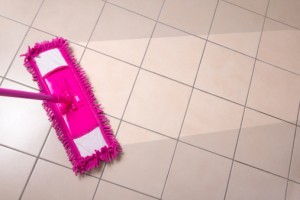Tile Maintenance
Learn how to keep your tile looking its best
Provided you purchase high-quality tile with an appropriate wear rating, a tile floor can last for decades without ever requiring refinishing. Here are some maintenance tips to help you care for your tile flooring and keep it looking its best as long as possible.
Preventative Care
 One of the most common problems that floor tile can have is scratching or abrasion. You can help prevent this simply by making an effort to keep sand, grit, and other debris off your floor. Vacuum and sweep with a dust mop regularly to remove large and fine grit particles. You can also add mats in entry ways or runner rugs in high-traffic areas to help keep grit from getting tracked into your home and ground into the tile by passing feet. It’s also a good idea to put feet protectors or felt pads under any heavy furniture you may have to prevent them from gouging your tile.
One of the most common problems that floor tile can have is scratching or abrasion. You can help prevent this simply by making an effort to keep sand, grit, and other debris off your floor. Vacuum and sweep with a dust mop regularly to remove large and fine grit particles. You can also add mats in entry ways or runner rugs in high-traffic areas to help keep grit from getting tracked into your home and ground into the tile by passing feet. It’s also a good idea to put feet protectors or felt pads under any heavy furniture you may have to prevent them from gouging your tile.
Cleaning
All you need to use to clean your tile floor is a damp mop and a gentle cleaning solution. Avoid abrasive or acidic cleaners, including ammonia- and bleach-based products, as these could actually damage the tile instead of cleaning it. To avoid any risk of staining, be sure to clean up any spills promptly.
Grout Care
In any tiled surface, the grout is the component that is most likely to experience a problem. Without proper cleaning, grout can develop mold and mildew and become discolored. Sealing your grout periodically should help. Before you seal the grout, make sure it is clean and dry to avoid trapping dirt or mildew on the grout forever.
Tile Repair
Over the years, your tile floor may require the occasional small repair. It’s a good idea to have a few extra tiles on hand from the original installation job, so you can be assured of a perfect match for any broken tiles. When making a tile repair, it’s important to do the job right so that your work doesn’t actually cause more problems down the line. The first step is to carefully and completely remove the damaged tile. Be sure to also remove all of the old grout around the broken tile. Scrape away the old mortar or adhesive that was under the tile to create a fresh and clean surface. Then you can apply the new mortar to the back of the replacement tile and gently push it into place. Make sure it is level and flush with neighboring tiles, then regrout around the perimeter of the tile. As a final step you may wish to seal the new grout to prevent staining and mildew. Once this is all done, you should have a new tile that is completely indistinguishable from the surrounding tiles.
